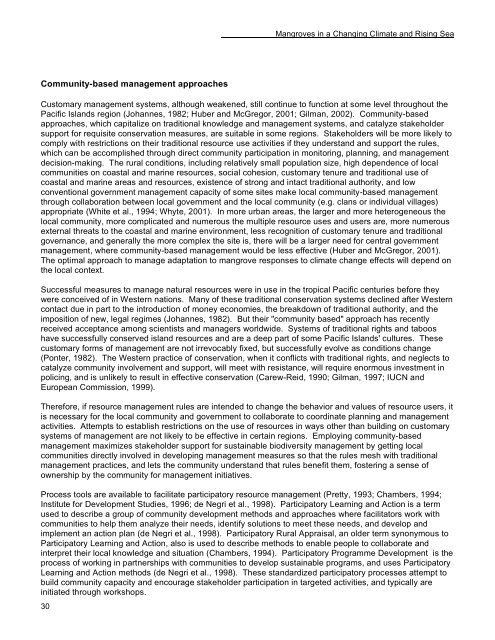Pacific Island Mangroves in a Changing Climate and Rising Sea
Pacific Island Mangroves in a Changing Climate and Rising Sea
Pacific Island Mangroves in a Changing Climate and Rising Sea
Create successful ePaper yourself
Turn your PDF publications into a flip-book with our unique Google optimized e-Paper software.
Community-based management approaches<br />
30<br />
<strong>Mangroves</strong> <strong>in</strong> a Chang<strong>in</strong>g <strong>Climate</strong> <strong>and</strong> Ris<strong>in</strong>g <strong>Sea</strong><br />
Customary management systems, although weakened, still cont<strong>in</strong>ue to function at some level throughout the<br />
<strong>Pacific</strong> <strong>Isl<strong>and</strong></strong>s region (Johannes, 1982; Huber <strong>and</strong> McGregor, 2001; Gilman, 2002). Community-based<br />
approaches, which capitalize on traditional knowledge <strong>and</strong> management systems, <strong>and</strong> catalyze stakeholder<br />
support for requisite conservation measures, are suitable <strong>in</strong> some regions. Stakeholders will be more likely to<br />
comply with restrictions on their traditional resource use activities if they underst<strong>and</strong> <strong>and</strong> support the rules,<br />
which can be accomplished through direct community participation <strong>in</strong> monitor<strong>in</strong>g, plann<strong>in</strong>g, <strong>and</strong> management<br />
decision-mak<strong>in</strong>g. The rural conditions, <strong>in</strong>clud<strong>in</strong>g relatively small population size, high dependence of local<br />
communities on coastal <strong>and</strong> mar<strong>in</strong>e resources, social cohesion, customary tenure <strong>and</strong> traditional use of<br />
coastal <strong>and</strong> mar<strong>in</strong>e areas <strong>and</strong> resources, existence of strong <strong>and</strong> <strong>in</strong>tact traditional authority, <strong>and</strong> low<br />
conventional government management capacity of some sites make local community-based management<br />
through collaboration between local government <strong>and</strong> the local community (e.g. clans or <strong>in</strong>dividual villages)<br />
appropriate (White et al., 1994; Whyte, 2001). In more urban areas, the larger <strong>and</strong> more heterogeneous the<br />
local community, more complicated <strong>and</strong> numerous the multiple resource uses <strong>and</strong> users are, more numerous<br />
external threats to the coastal <strong>and</strong> mar<strong>in</strong>e environment, less recognition of customary tenure <strong>and</strong> traditional<br />
governance, <strong>and</strong> generally the more complex the site is, there will be a larger need for central government<br />
management, where community-based management would be less effective (Huber <strong>and</strong> McGregor, 2001).<br />
The optimal approach to manage adaptation to mangrove responses to climate change effects will depend on<br />
the local context.<br />
Successful measures to manage natural resources were <strong>in</strong> use <strong>in</strong> the tropical <strong>Pacific</strong> centuries before they<br />
were conceived of <strong>in</strong> Western nations. Many of these traditional conservation systems decl<strong>in</strong>ed after Western<br />
contact due <strong>in</strong> part to the <strong>in</strong>troduction of money economies, the breakdown of traditional authority, <strong>and</strong> the<br />
imposition of new, legal regimes (Johannes, 1982). But their "community based" approach has recently<br />
received acceptance among scientists <strong>and</strong> managers worldwide. Systems of traditional rights <strong>and</strong> taboos<br />
have successfully conserved isl<strong>and</strong> resources <strong>and</strong> are a deep part of some <strong>Pacific</strong> <strong>Isl<strong>and</strong></strong>s' cultures. These<br />
customary forms of management are not irrevocably fixed, but successfully evolve as conditions change<br />
(Ponter, 1982). The Western practice of conservation, when it conflicts with traditional rights, <strong>and</strong> neglects to<br />
catalyze community <strong>in</strong>volvement <strong>and</strong> support, will meet with resistance, will require enormous <strong>in</strong>vestment <strong>in</strong><br />
polic<strong>in</strong>g, <strong>and</strong> is unlikely to result <strong>in</strong> effective conservation (Carew-Reid, 1990; Gilman, 1997; IUCN <strong>and</strong><br />
European Commission, 1999).<br />
Therefore, if resource management rules are <strong>in</strong>tended to change the behavior <strong>and</strong> values of resource users, it<br />
is necessary for the local community <strong>and</strong> government to collaborate to coord<strong>in</strong>ate plann<strong>in</strong>g <strong>and</strong> management<br />
activities. Attempts to establish restrictions on the use of resources <strong>in</strong> ways other than build<strong>in</strong>g on customary<br />
systems of management are not likely to be effective <strong>in</strong> certa<strong>in</strong> regions. Employ<strong>in</strong>g community-based<br />
management maximizes stakeholder support for susta<strong>in</strong>able biodiversity management by gett<strong>in</strong>g local<br />
communities directly <strong>in</strong>volved <strong>in</strong> develop<strong>in</strong>g management measures so that the rules mesh with traditional<br />
management practices, <strong>and</strong> lets the community underst<strong>and</strong> that rules benefit them, foster<strong>in</strong>g a sense of<br />
ownership by the community for management <strong>in</strong>itiatives.<br />
Process tools are available to facilitate participatory resource management (Pretty, 1993; Chambers, 1994;<br />
Institute for Development Studies, 1996; de Negri et al., 1998). Participatory Learn<strong>in</strong>g <strong>and</strong> Action is a term<br />
used to describe a group of community development methods <strong>and</strong> approaches where facilitators work with<br />
communities to help them analyze their needs, identify solutions to meet these needs, <strong>and</strong> develop <strong>and</strong><br />
implement an action plan (de Negri et al., 1998). Participatory Rural Appraisal, an older term synonymous to<br />
Participatory Learn<strong>in</strong>g <strong>and</strong> Action, also is used to describe methods to enable people to collaborate <strong>and</strong><br />
<strong>in</strong>terpret their local knowledge <strong>and</strong> situation (Chambers, 1994). Participatory Programme Development is the<br />
process of work<strong>in</strong>g <strong>in</strong> partnerships with communities to develop susta<strong>in</strong>able programs, <strong>and</strong> uses Participatory<br />
Learn<strong>in</strong>g <strong>and</strong> Action methods (de Negri et al., 1998). These st<strong>and</strong>ardized participatory processes attempt to<br />
build community capacity <strong>and</strong> encourage stakeholder participation <strong>in</strong> targeted activities, <strong>and</strong> typically are<br />
<strong>in</strong>itiated through workshops.

















